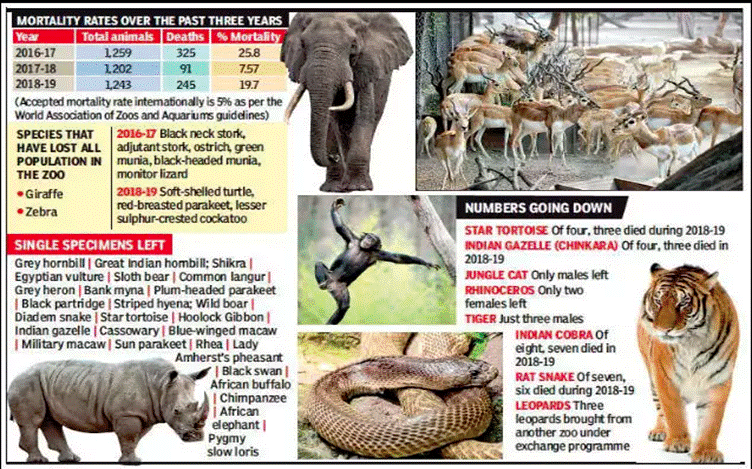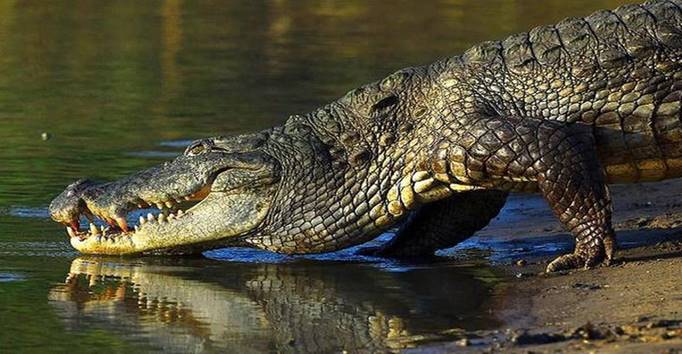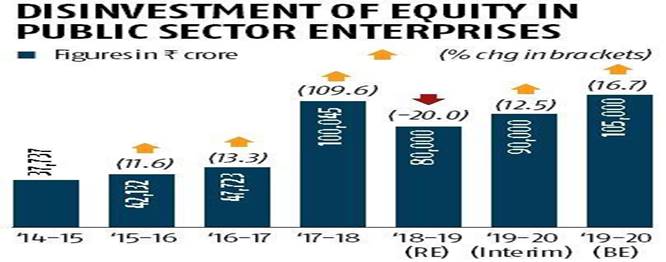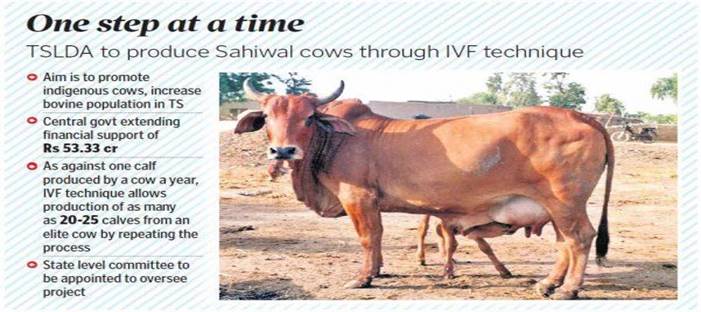



245 deaths in 14 months: Delhi zoo orders analysis
245 deaths in 14 months: Delhi zoo orders analysis
News Important for: GS – 3 I Bio diversity
Context
The National Zoological Park directed to maintain a separate record of animal’s death in the zoo.
Analysis
â— In the recent times, death of 245 animals have been reported over 14 months.
â— The deaths were mainly due to old age and infighting among animals according to the authorities.
â— There have been multiple irregularities in the zoo, including false post-mortem reports of animals and negligence in taking care of them.
â— The court ordered a strict look into the matter to find out the exact reason of deaths of animals and further implementation of guidelines to protect their lives.

Causes of death
â— Diseases may be ‘of concern’ to zoos either because of the direct risk of animal loss or because of the impact on the zoo of required measures in the case of an outbreak.
â— Each zoo will have different ‘diseases of concern’, depending on its geographical location and the types of animal in its collection, which may vary quite widely from collection to collection, and over time.
â— Diseases can be considered under four broad headings for all zoos:
⮚ infectious diseases
⮚ degenerative diseases
⮚ genetic diseases
⮚ nutritional diseases
Way Forward
â— The zoo should develop and implement an animal-care training program.
â— The zoo should develop performance measures to monitor the operations of animals
â— Programs
â— The strategic plan should directly link the plan for revitalizing the physical facilities with the animal
â— The zoo’s Safety Department should continue to shift its emphasis toward a more proactive, anticipatory role rather than reacting to events as they occur.
Source link:
Odisha renews effort to revive gharial population
News Important for: GS – 3 I Environment and Bio diversity
Context
Odisha has released 5 gharials in the Satkosia gorge of Mahanadi.

About
â— It is done in the direction to renew Odisha’s effort to revive the status of gharials from critically endangered species of crocodile.
â— These gharials, include three females and two males. They were bred at the Nandankanan Zoological Park.
|
Nandankanan Zoological Park
â— Nandankanan, literally meaning The Garden of Heaven, is located near Bhubaneswar, Odisha. â— Unlike other zoos in the country, Nandankanan is built right inside the forest and set in a completely natural environment. â— Nandankanan is among the six participating zoos for the conservation breeding of White-backed vulture. â— First zoo in the World to breed White tiger and Melanistic tiger. â— Only conservation breeding centre of Indian Pangolin in the world. â— Only zoological park in India to become an institutional member of World Association of Zoos and Aquarium (WAZA). â— Gharials have bred for the first time in captivity in the world at Nandankanan Zoological Park in 1980. â— The first zoo in India where endangered Ratel was born in captivity.
|
â— The gharials are individually marked and fitted with radio transmitters for future identification and tracking of their migration route.
Crocodiles in India
â— There are three species of crocodilians—saltwater, Mugger and Gharial.
Mugger
â— The mugger crocodile, also called the Indian crocodile, or marsh crocodile, is found throughout the Indian subcontinent.
â— It is listed as vulnerable by IUCN.
â— The mugger is mainly a freshwater species, and found in lakes, rivers and marshes.
Gharial
â— The Gharial or fish eating crocodile is native to the Indian subcontinent.
â— It is listed as Critically Endangered by IUCN.
â— Small released populations are present and increasing in the rivers of the National Chambal Sanctuary, Katarniaghat Wildlife Sanctuary, Son River Sanctuary and the rainforest biome of Mahanadi in Satkosia Gorge Sanctuary, Orissa.
Saltwater Crocodile
â— It is the largest of all living reptiles. It listed as least concern by IUCN. It is found throughout the east coast of India.
â— Odisha is the only State in India having all three species gharial, mugger and saltwater crocodile.
â— The State forest department began conservation of these crocodile species in 1975 by establishing three rearing centres Tikarpada for gharials in Angul district, Ramatirtha for muggers in Mayurbhanj and Bhitarkanika for saltwater crocodiles in Kendrapara district.
Source link:
Govt. must reduce borrowing by divesting stake in PSEs: Acharya
News Important for: GS – 3 I Economic development, Policy and regulations
Context
The deputy governor of RBI has suggested the government should invest more in public sector in order to eliminate the crowding out effect.

Analysis
â— The crowding out effect: It occurs when the government borrows money from the market and there is no money left in the market for private sector to borrow.
â— To eliminate the crowding out effect former RBI deputy governor suggested the government to invest more in public sector.
â— Focus on long term goals to extract maximum advantage instead to short term goals will boost the economy.
â— He also said that serious rationalisation could be undertaken including cutting back on subsidies and programmes that are not delivering long-term growth.
â— There could be efficiency gains if there are more private investors playing an effective role in the governance of public sector enterprises.
â— It will also reduce the need for market borrowings by the government and reduce crowding-out.
â— The land, labour and agricultural reforms could be undertaken, to help crowd-in private sector growth.

Source link:
Plea in SC seeks action to save numbers of indigenous cows
News Important for: GS – 3 I Bio diversity
Context
Concerns have been raised because of continuous decrease in the number of cows in the country.

Analysis
â— The decrease is due to indiscriminate slaughter and cross breeding.
â— The petition filed claims that the National Green Tribunal has failed to pass any directions despite the miserable conditions of cows.
â— There has been depletion in the number of indigenous cows due to import of exotic bulls and cross breeding.
â— These indigenous cows are slaughtered and hybridisation tends to reduce their percentage.
â— Government should take some prominent steps to save the decreasing number of indeginious cows in the country in order to save the environment and biodiversity.
Source link:
What’s NEXT?
News Important for: GS – 3 I Education and Human resource
Context
A unified exam by removing all exams at MBBS exist level has been introduced by Government.

Analysis
â— The National Medical Commission Bill is proposed to replace the Medical Council Act, 1956.
â— The National Medical Commission will have authority over medical education approvals for colleges, admissions, tests and feeï¬xation.
â— The Bill proposes to unify testing for exit from the MBBS course, and entry into postgraduate medical courses.
â— A single National Exit Test (NEXT) will be conducted across the country replacing the ï¬nal year MBBS exam, and the scores used to allot PG seats as well.
â— It will allow medical graduates to start medical practice, seek admission to PG courses, and screen foreign medical graduates who want to practise in India.
â— It offers a deï¬nite beneï¬t for students who invest much time and energy in ï¬ve years of training in classrooms, labs and the bedside, by reducing the number of tests they would have to take in case they aim to study further.
â— States such as Tamil Nadu are still politically opposing the National Eligibility cum Entrance Test (NEET) they also believe that NEXT will undermine the federal system.
◠They raise objections as a test at the MBBS level would suffice as an entry criterion for PG courses.
â— The Bill has also removed the exemption hitherto given to Central institutions, the AIIMS and JIPMER, from NEET for admission to MBBS and allied courses.
â— The government has also decided to scrap a proposal in the original Bill to conduct an additional licentiate exam that all medical graduates would have to take in order to practise, in the face of virulent opposition.
â— It also removed, rightly, a proposal in the older Bill for a bridge course for AYUSH practitioners to make a lateral entry into allopathy.
Conclusion
NEXT has to try to eliminate obstacles and controversies as NEET for better implementation and time bound execution.
Source link:
https://www.thehindu.com/opinion/editorial/whats-next/article28660551.ece

© 2025 iasgyan. All right reserved